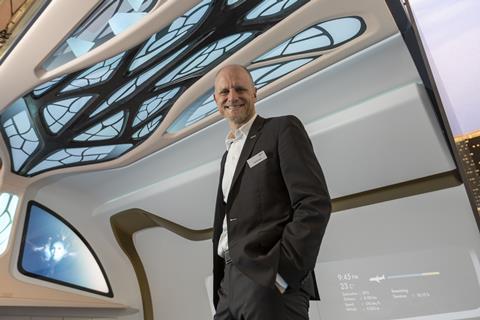While Diehl Aviation was at AIX highlighting the potential for artificial intelligence and recycled materials to bring further innovation to future aircraft cabins, the company’s senior vice-president product innovation Carsten Laufs flags many of the gains are already deliverable.
The cabin specialist pitched its presence at the show around solutions for “today, tomorrow and the future”, exhibiting a mix of products available now together with some potential future concepts for the cabin.

”Some examples are already available today,” explains Laufs. ”Others are further away. So we are preparing to be ready now for cabin modernisations, but also this cabin future concept is taking us into the next generation of aircraft by the end of the decade and into the next decade.
“Today there is a major focus on weight reduction, it is something we can realise right now, and is already being realised,” Laufs adds.
One example Diehl exhibited is a new material and design for overhead bins, the inner shell of which can be removed – replaced and recycled if required – without requiring the whole bin to be taken out.
”We are working on it right now, transferring it into industrialisation so that it is available tomorrow and into the future. So you can see the step from these material uses to the next one,” says Laufs.
”Sustainability is not limited to weight reduction,” he adds. “It’s not limited to recycled materials. It’s also about energy efficient systems. Just use less energy in order to operate the cabin.”
Further ahead Diehl believes there are further advances in the use of sustainable materials, as well as AI in enhancing the onboard passenger experience. These were on show at its future cabin concept.
”We are combing two things,” Laufs says. ”One is AI supported passenger experience in support of the MRO and the other is sustainability and weight reduction.”
Diehl is demonstrating how AI can be used to both enhance integration of the passenger experience – by providing relevant information connected to the passenger’s journey – as well as operationally for the crew in terms monitoring inventory and maintenance aspects. ”So we take these smart AI opportunities to support predictive health maintenance,” Laufs says.
It also supports its futuristic cabin, which among other things illustrates how AI could be used to create displays that could partially replace windows onboard, and thus further reduce weight. This combines with what it calls “bionic structures”, which use lightweight recycled materials for the decorative rather than structural parts of the cabin wall.
“This is just enhancing the passenger experience, using our light application scenarios combined with structural elements to give you complete new freedom of industrial design,” says Laufs.


























